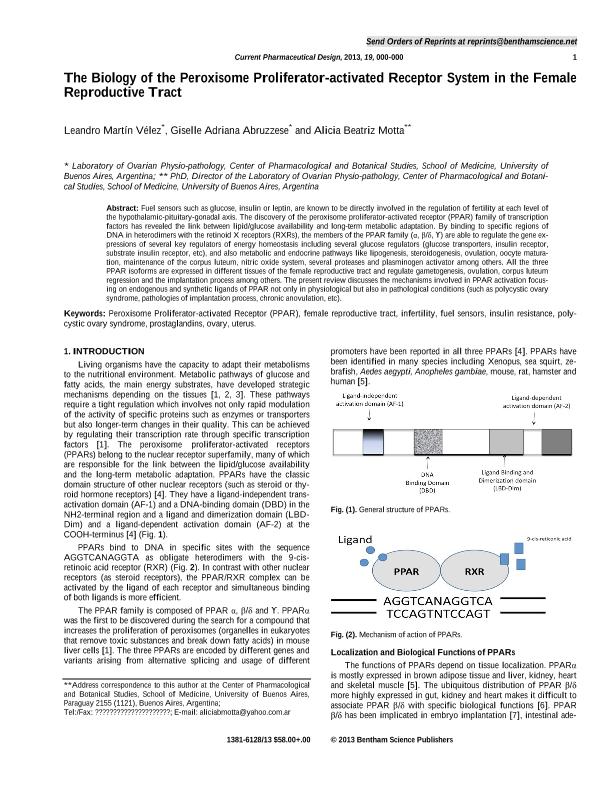Mostrar el registro sencillo del ítem
dc.contributor.author
Velez, Leandro Martin

dc.contributor.author
Abruzzese, Giselle Adriana

dc.contributor.author
Motta, Alicia Beatriz

dc.date.available
2016-11-30T17:27:18Z
dc.date.issued
2013-04
dc.identifier.citation
Velez, Leandro Martin; Abruzzese, Giselle Adriana; Motta, Alicia Beatriz; The Biology of the Peroxisome Proliferator-activated Receptor System in the Female Reproductive Tract; Bentham Science Publishers; Current Pharmaceutical Design.; 19; 25; 4-2013; 4641-4646
dc.identifier.issn
1381-6128
dc.identifier.uri
http://hdl.handle.net/11336/8513
dc.description.abstract
Fuel sensors such as glucose, insulin or leptin, are known to be directly involved in the regulation of fertility at each level of the hypothalamic-pituitary-gonadal axis. The discovery of the peroxisome proliferator-activated receptor (PPAR) family of transcription factors has revealed the link between lipid/glucose availability and long-term metabolic adaptation. By binding to specific regions of DNA in heterodimers with the retinoid X receptors (RXRs), the members of the PPAR family (α, β/δ, γ) are able to regulate the gene expressions of several key regulators of energy homeostasis including several glucose regulators (glucose transporters, insulin receptor, substrate insulin receptor, etc), and also metabolic and endocrine pathways like lipogenesis, steroidogenesis, ovulation, oocyte maturation, maintenance of the corpus luteum, nitric oxide system, several proteases and plasminogen activator among others. All the three PPAR isoforms are expressed in different tissues of the female reproductive tract and regulate gametogenesis, ovulation, corpus luteum regression and the implantation process among others. The present review discusses the mechanisms involved in PPAR activation focusing on endogenous and synthetic ligands of PPAR not only in physiological but also in pathological conditions (such as polycystic ovary syndrome, pathologies of implantation process, chronic anovulation, etc).
dc.format
application/pdf
dc.language.iso
eng
dc.publisher
Bentham Science Publishers

dc.rights
info:eu-repo/semantics/openAccess
dc.rights.uri
https://creativecommons.org/licenses/by-nc-sa/2.5/ar/
dc.subject
Peroxisome-Proliferator Activated Receptor
dc.subject
Polycystic Ovary Syndrome
dc.subject
Insulin Resistance
dc.subject
Infertility
dc.subject.classification
Obstetricia y Ginecología

dc.subject.classification
Medicina Clínica

dc.subject.classification
CIENCIAS MÉDICAS Y DE LA SALUD

dc.title
The Biology of the Peroxisome Proliferator-activated Receptor System in the Female Reproductive Tract
dc.type
info:eu-repo/semantics/article
dc.type
info:ar-repo/semantics/artículo
dc.type
info:eu-repo/semantics/publishedVersion
dc.date.updated
2016-11-24T17:21:27Z
dc.journal.volume
19
dc.journal.number
25
dc.journal.pagination
4641-4646
dc.journal.pais
Estados Unidos

dc.journal.ciudad
Oak Park
dc.description.fil
Fil: Velez, Leandro Martin. Consejo Nacional de Investigaciones Científicas y Técnicas. Oficina de Coordinación Administrativa Houssay. Centro de Estudios Farmacológicos y Botánicos; Argentina
dc.description.fil
Fil: Abruzzese, Giselle Adriana. Consejo Nacional de Investigaciones Científicas y Técnicas. Oficina de Coordinación Administrativa Houssay. Centro de Estudios Farmacológicos y Botánicos; Argentina
dc.description.fil
Fil: Motta, Alicia Beatriz. Consejo Nacional de Investigaciones Científicas y Técnicas. Oficina de Coordinación Administrativa Houssay. Centro de Estudios Farmacológicos y Botánicos; Argentina
dc.journal.title
Current Pharmaceutical Design.

dc.relation.alternativeid
info:eu-repo/semantics/altIdentifier/url/http://www.eurekaselect.com/111709/article
dc.relation.alternativeid
info:eu-repo/semantics/altIdentifier/doi/http://dx.doi.org/10.2174/1381612811319250010
Archivos asociados
